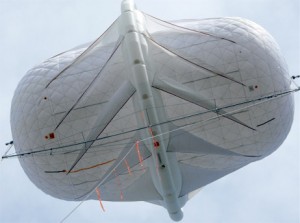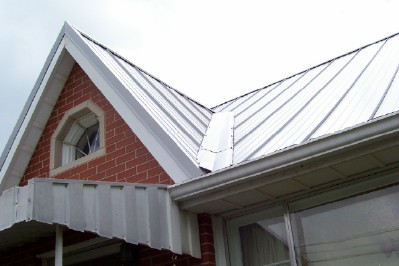After an extended meditation like I just concluded on the Federal Energy Tax Credits (please click 2008 elections, international environmental groups and religion categories for more examples), I am always at a loss for where to go next. I find it useful to just blow it out! So from Live Science and Yahoo I bring you some of the most implausible energy thoughts ever encountered by man:
http://news.yahoo.com/s/livescience/powerfulideasmileshighkitescouldgenerateelectricity
http://www.livescience.com/environment/090622-kite-wind-power.html
Environment
Powerful Ideas: Miles-High Kites Could Generate Electricity
By Charles Q. Choi, Special to LiveScience
posted: 22 June 2009 08:21 am ET
Full Size


1 of 1

- Airborne turbines like these depicted in this illustration could generate electricity from strong high-altitude winds. Credit: Ben Shepard, courtesy Sky WindPower
Editor’s Note: This occasional series looks at powerful ideas — some existing, some futuristic — for fueling and electrifying modern life.
The sky might literally be the limit for wind power — rotors spinning miles high could help supply electricity worldwide.
“There is a huge amount of energy available in high-altitude winds,” said researcher Ken Caldeira at the Carnegie Institution’s Department of Global Ecology in Stanford, Calif. “These winds blow much more strongly and steadily than near-surface winds, but you need to go get up miles to get a big advantage. Ideally, you would like to be up near the jet streams, around 30,000 feet.”
All told, if wind turbines miles above the planet were tethered to 10 percent of the world’s land, there is enough energy in these jet stream winds to meet world demand 100 times over, researchers said.
Jet streams are meandering belts of fast winds at altitudes between 20,000 and 50,000 feet. They shift seasonally, but are otherwise persistent features in the atmosphere. Jet stream winds are generally steadier and 10 times faster than wind near the ground, making them a potentially vast and dependable source of energy.
But how to capture the wind so high?
Kites and tethers
A number of technological schemes have been proposed to harvest energy from these high-altitude winds, including tethered, kite-like wind turbines lofted miles high. Up to 40 megawatts of electricity could be generated by current designs and transmitted to the ground via tether.
Using 28 years of weather data, the researchers developed the first-ever global survey of high-altitude wind energy.
“We found the highest wind power densities over Japan and eastern China, the eastern coast of the United States, southern Australia, and north eastern Africa,” said researcher Cristina Archer, an atmospheric scientist at California State University in Chico.
:}
You can go to the Energies site to see the scientific part of the study:
http://www.mdpi.com/1996-1073/2/2/340
Mesoscale Simulation of Year-to-Year Variation of Wind Power Potential over Southern China
Steve H. Yim 1  , Jimmy C. Fung 1,2
, Jimmy C. Fung 1,2  and Alexis K. Lau 1,3,*
and Alexis K. Lau 1,3,* 
1 Institute for the Environment, The Hong Kong University of Science and Technology, Hong Kong, China
2 Department of Mathematics, The Hong Kong University of Science and Technology, Hong Kong, China
3 Department of Civil and Environmental Engineering, The Hong Kong University of Science and Technology, Hong Kong, China
* Author to whom correspondence should be addressed.
Received: 27 April 2009; in revised form: 27 May 2009 / Accepted: 1 June 2009 / Published: 3 June 2009
 Download PDF Full-Text (1202 KB)
Download PDF Full-Text (1202 KB)
Abstract: The objectives of this study are to combine historical observations and state-of-the-art numerical models (MM5/CALMET system) to map the spatial distribution of wind resources in high resolution, and to help foster a deeper understanding of the wind power potential over southern China (Guangdong). Hourly wind fields were simulated for three entire years (2004-2006). It found that almost 70% of the time, the wind speed along the coast of Guangdong is over 5 m/s, which is deemed a baseline magnitude for typical wind turbines. Spatial plots of the wind speed and power and their variations over Guangdong Province for the three years are also presented.
:}
For the SEX part of it…Generating energy from the jet stream …well it is awful high up there (40-50 miles), really really cold (100 degrees below zero) and really close to the cosmic rays…and it has been around for awhile. I mean looking up is to dream right?
http://www.youtube.com/watch?v=SVi_-dlDVcw
http://sleepgreen.info/?tag=energy
Comments (0)
Posted by admin | Green News | Wednesday 21 January 2009 2:43 pm
Dutch astronaut Dr Wubbo Ockels has successfully demonstrated i Netherlands his new energy concept. He has flown a high-flying energy kite, creating kinetic energy from huge radio-controlled highflying kites. He has designed ‘ladder-mills’ to store the kinetic energy and convert it into electricity.
Three such ladder-mills provide enough electricity to power one city. The experiment was carried out along the northern coastline of The Netherlands where there’s usually more than enough wind to raise the gigantic kites into.The radio- controlled, high-flying kites can create some 10,5kw electricity each, Dr Ockels told a local radio station.High-altitude kites could be used to generate clean energy at a cost comparable with that of fossil fuel generation , researchers claim.The “Ladder-Mill” is a chain of controllable wing-like kites attached to a looped cable stretching more than five miles into the sky.Strong high altitude winds acting on the “kitewings” produce as upward force on one side of the loop and a downward force on the other, causing it to rotate.The slowly turning cable drives a power generator in the Ladder-Mill base station.Although the concept sounds far fetched, its developers at Delft Technical University in the Netherlands hope to build a working model in the next four years.
They claim one Ladder-Mill could generate 100 megawatts of electricity, compared with only a few megawatts from a conventional wind turbine.
Winds at 30,000ft are 20 times more powerful than at sea level.
Professor Ockels, an ex-astronaut and head of the European Space Agency’s education office, told The Engineer magazine: “Above a certain altitude there is a massive amount of wind power.
Source:
http://alt-e.blogspot.com/2004/12/wind-power-laddermills-high-altitude.html
http://www.rense.com/general78/kinet.htm

:}
Did you know that people have even tried to use kites for COMMERCIAL FISHING?
http://en.wikipedia.org/wiki/Kite_applications
Kite applications
From Wikipedia, the free encyclopedia
Jump to: navigation, search
The kite is used to do certain things; one kite or many kites are applied to achieve certain purposes, objectives, or tasks, that is: applications. Humans have applied the kite to bring perceived benefits during peace and war alike. New applications for the kite continue to be found. Only some innovative applications appear in national patents; others are communicated in newspapers, magazines, books, and internet pages. Air kites, water kites, bi-media kites, fluid kites, gas kites, kytoons, paravanes, soil kites, solid kites, and plasma kites have niche applications that are furthering the interests of humans. Non-human-made kites have applications; some spiders make use of kiting.
:}
If you click on 17 or 24 you can see the energy apps. By the way # 24 is funded by Google.
:}














